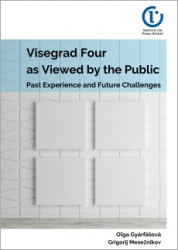This is the archival site of the former V4 portal. As of July 2024, it is no longer updated.
Visit visegrad.group for the current website.
Visit visegrad.group for the current website.

Thu 8 January 2026
Warszawa (PL)
4/2°C
| Tue | Wed | Thu | Fri | Sat |
|---|---|---|---|---|
| 1 | 3 | 5 | 6 | 8 |
Thu 8 January 2026
Praha (CZ)
6/2°C
| Tue | Wed | Thu | Fri | Sat |
|---|---|---|---|---|
| 6 | 5 | 8 | 8 | 9 |
Thu 8 January 2026
Bratislava (SK)
6/-1°C
| Tue | Wed | Thu | Fri | Sat |
|---|---|---|---|---|
| 8 | 6 | 7 | 8 | 8 |
Thu 8 January 2026
Budapest (HU)
5/-2°C
| Tue | Wed | Thu | Fri | Sat |
|---|---|---|---|---|
| 6 | 6 | 6 | 9 | 8 |
Nonexistent Cities
by Radoslav Tomáš
I
For a long time now, a city has not been just a system of several streets, buildings, parks or markets. Neither is it a cathedral or church, one or another coffee shop, square, several fountains, a parking lot. It is not even the sum of all these things at the same place. The city is not.
You have the right then to ask, what is a city, if such lay enumeration is inadequate for a definition. Freedom, experienced by an eye, while looking at a particular place? Latent presence (potentiality, summary) of endless numbers of possible views? Structure, evoking some kind of undetermined image? Or architecture, which uses (on purpose? subconsciously? cannot do it any other way?) its means in order to create results that are accidental, disturbed, broken, and chaotic? Or does the city itself create relationships inside it, which contradict our usual principles of feeling the norm?
When absorbing the city, we are pushed by multiplicity, multiple stratification, complexity, immediately followed by breaking the rules, denial, fragmentation, or even conscious classification in the sense of some kind of selective censure (not this, not this, yes this) - thinking, perception, feeling (of the city). And after so many abstracts, in the end, the only thing left is a vague conflict. The city ceases to be important. After all, a regular consumer does not need an opinion of a city. And he does not want it either. He lost his will to resolve anything a long time ago - in relationships, in politics, in culture. Let alone in some kind of city...
From another angle, one could also ask whether the subject of the city does not fall below the level of its objects. That would mean that it interchanges with them, dissolves in them. And a man (the interpreter of the city) then does not have much of a choice - the city is crumbling between his fingers into endless fragments. Then how can one speak of some kind of idealistic organization of phenomena towards a higher principle or perhaps even a law? Without principles, there is nothing today, no morals, no thinking, no feeling. Who will then pause to ponder that there is nothing like a city here?
II
A city is an uncertain place. An anchorless mobility in firm finite coordinates of forms and empty stereotypes. An uncertain kind of soil, changeability, restlessness. Paradoxically, all of this may represent the only foothold, which allows us to talk about something like a city, its structure, architecture, meaning.
A city may be a capturing of reality on a relatively small surface area, some kind of photograph of a human inside, which the city built, gave it its own face. Speaking in vulgar terms, a city may also be some kind of a can - with minimal fundamental signs of nature (or is another term more appropriate, a term that so many urban designers like to use: second nature?). But. We have to look at the nonexistence of what we all clearly see from another side. I am sure we will all agree that a city contains all kinds of various determinant elements, realities or categories, pointing to the fact that the reality and significance of the city in it are not created from nothing, that they are not just a mere result of coincidence when connecting streets and designing public spaces and buildings, but they are created by human will, some kind of author's concept. And that when wandering around the city, a pedestrian (city resident, tourist, accidental visitor) is left with his own ability to fill these elements, facts, categories and signs with his own esthetic, philosophic or experience implications. Perhaps this way the city strives for cooperation, some kind of inner dialogue of multiple parties. The city becomes an exclusive inner world and the experience of a particular person.
A city seen from this perspective reflects hinted, fragmented and disjointed elements against the absolutist testimonies of its reality, yet at the same time it as if tries to reach for the composed montage in a man's mind, with the structure occasionally reminiscent of a knife cut, just like a capability to perceive only a part of the whole. If we want to understand the city through a plan, which we conveniently got used to, like when reading instructions for use or watching television, then we become disoriented, we will not capture its true rhythm and melody; and what we find can be marked as incomprehensible, too wide, indefinable.
Speaking of city, perhaps it is also very important how things are said, not only what is being said - and this way, in this sense, the content of the city is something that defines the possibilities of forms of the city. The city then qualifies its own approach as such, where the form and content materialize in a particular person at the same time, and one cannot precede another as an option. And that is why the city itself, in opposition to that uncertainty and mobility, also evokes a certain order, given by the inner effort to align or harmonize the human situation in a precise, albeit closed space.
At the same time it needs to be notes that the city as such does not exist in the present, it is a result of something that was formed gradually, and therefore it changed its character with its individual likenesses, or possibilities, if you like. Gradually, the city lost its connection to the original situation, which was the initial trigger for its establishment, and the city slowly got into two positions, or rather in between them - between the sober historic impersonal records that something has changed and the statistic is such and such, and the sentimental (subjective) confessions of some older, possibly distinguished citizens. However, with each new likeness, each new possibility, the city organizes itself, stabilizes. Therefore we have to admit - the city, the existence of which we deny, still contains something stabile. The street order, location of parks, squares, gradual formation of more or less important sites, or the entire abstract image of the city - all of this is much more important than it may seem. It begs the question: so how is it then? Does it exist or not? Or is its nonexistence just another likeness, another possibility?
One has to be careful here - if a man really wants to grasp something and understand it, he must not forget that he cannot determine the extent of this possibility. He may be consoled by the fact that at least he can recognize it and use it for his benefit.
III
So here, in front of me, the city breaks, somehow. Not only into two halves - one uncertain and intangible, of which I am convinced that it does not exist, and the other, which represents the closed and defined space, where a coincidence seems random. The city in front of me literally crumbles into millions of tiny pieces, which are starting to float in the air. And I am forced to watch that movement, follow it like a dancer, like rhythm. I am forced to watch it assume different masks, how quickly it changes the definition of a term, how it differentiates, how it acts as if in a theater. The city wants me to believe its masks.
One of them changes into a tree under which we started a secret society as little boys. Of course, we fought the entire world. Another one has the image of my best friend, who used to hide my books in school so that I would not read so much. The third one reminds me of an uphill road. There was a cemetery on that hill where we had our first smoke. Another one is a wall, which buzzed like bees under the ivy roller blinds; yet another one is a creek, which I fell into after breaking the ice, and then got a beating from my mom only because she was so scared for me.
These are not any big things, they are rather inconspicuous and quiet, and often we don't even know about them. But in certain moments they may assume giant dimensions. This process is called nostalgia. That is why old men can sit on benches for hours without a movement, without a word. Their sights are turned somewhere inside, yet at the same time to a far away place. This very moment they are looking at the bottom. Of their memories. Because only the memories can withstand the lapse of time, they do it in peculiar way, but only they remain. This way they give the city its shape as some kind of a dress, which undertakes eternity in its constant movement ahead. The content of a city is then really what determines its form, but always only for a particular person.
That means that each term remains empty until someone moves in. Because the more the city becomes something intangible, abysmal, unattainable, submerged into other worlds for me, the more I feel the need of a real and concrete place, not just a general term, but a city, where I can run into an acquaintance in the street and I know to which café I might take him. A city, which sins like a man and which can secretly drink at night, which cheats and loves. A city that can share and be honest. Otherwise the city makes not sense. It will stay empty, drowned in the verbalism of surreal.
The dimensions of the city are therefore the dimensions of the freedom of an individual. They create a world, which contains the basic, decisive, determinant, but also irritating conflict between openness and closeness - in us, in our thinking, in our contact with the city. No empty esthetics, no passive consumption, no masks and vacant gestures, no dictatorship, no "over there, beyond the mountains of reality". Only regular, conscious participation in the city, guaranteed by itself, its constant co-creation, free and imaginative movement of thoughts on their own volition and on their own path. Common movement. Perhaps that is the right word. Common. And on top of that, a little bit of courage with the commonality, with that concrete, everyday, sometimes routine humanity, always reeking of that oppressive cloud of smog, amidst irresponsible manipulated people sentenced by power to lies, half-truths, hypocrisy, collaboration, and general immobility. Perhaps that is the only real and existing city for me. Nothing else.
IV
You can find out as early as in school that just like the ancient man tried to harmonize his actions with the invisible cosmic order, he also tried to build his settlement. He tried to adapt the city like an earthly structure to the heavenly structure. The basic elements, which belonged to the old cities, included circle (like a picture of a horizon or zodiac), square (as a symbol of four cardinal directions) and coordinate system of streets. Each city was the center of its own universe. And since the city protected its residents and hid them like a mother would hide her own children, it was frequently personified by a motherly goddess, sometimes with a crown of stylized city walls.
However, today we can say that in the blind labyrinth of the city, the city as such has become a mere already mentioned vulgar can. Human relationships, economy, culture - all of that in an instantaneous form. Compressed to the highest possible level. And with that, fear of constantly developing technological progress. And from that, the element, which influences the city the most - speed. Whether we admit it or not, each one of us is constantly on the move. Today, movement is the determining unit and even when we lie in bed at home, the world around us keeps changing with a dizzying speed and we are a part of these changes. Speed in this movement disturbs the normally perceived space and time - it squeezes them, compresses them. The cities get compressed like that. Into cans. From an individual point of view, for some of them, down to zero level. Because speed (in the negative sense of the word) liberates from territoriality and breaks obstacles, which untie the connections like a shoestring, with which these individuals are tied to their city; in other words, it strips the city of the possibility to give them citizenship, identity. And so, when the distance no longer means anything, the city loses its meaning. Because the city itself, in return, also loses its identity. It ceases to exist. And we could start enumerating again - like in the beginning - what are all the things that city is not. Or perhaps it is enough to say that the city is not.
The problem seen from this angle may seem a bit intellectual, after all, a number of people remain in the city, who only have one option - to watch the ever growing speed. It is those, who are standing still. But as was already said - it is impossible not to move. And since these individuals are not those who actively invest into the city (as Albert J. Dunlap says), either way the city escapes from underneath their feet.
V
But in the end, something remains under the nails. Something that clutches to the real man, his childhood, past, dreams and imagination, something that persists. Perhaps it is that memory of ourselves, without which we would change everything we see (not only cities) into fragile pages from a book, with their unemotional and passive rustle in the wind. And perhaps it is just a simple hope, because the world is not saved by thoughts or intellect or brain, but by plain hope. And perhaps that is why I am a pessimist, because pessimism - as Ernesto Sabato says - first needs to hope for something and have faith. And that is why I am convinced that the city has long ceased to be this system of several streets, buildings, parks or markets. Neither is it a cathedral or a church, one or another coffee shop, square, several fountains, a parking lot. It is not even the sum of all these things at the same place. Because I alone am the city.
 back to Essay It!
back to Essay It!







